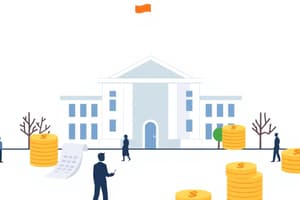Podcast
Questions and Answers
Which of the following is the most accurate description of a government budget?
Which of the following is the most accurate description of a government budget?
- A record of all financial transactions conducted by a country's citizens.
- An annual statement outlining projected government revenue and expenses. (correct)
- A detailed account of all taxes collected by the government in a fiscal year.
- A summary of a country's international trade activities and financial flows.
Which of these options represents a capital receipt for a government?
Which of these options represents a capital receipt for a government?
- Income Tax
- Proceeds from disinvestment (correct)
- Goods and Services Tax (GST)
- Interest earned on government investments
Which of the scenarios is the best indicator that a nation's Revenue Deficit is present?
Which of the scenarios is the best indicator that a nation's Revenue Deficit is present?
- Capital expenditure is greater than capital receipts.
- Total government borrowing is zero.
- Revenue expenditure exceeds revenue receipts. (correct)
- Total expenditure is less than total receipts
If a government aims to reduce its Fiscal Deficit, which action would be most effective?
If a government aims to reduce its Fiscal Deficit, which action would be most effective?
Which of the options is the most accurate representation of Primary Deficit calculation?
Which of the options is the most accurate representation of Primary Deficit calculation?
Which of these options is usually associated with an expansionary fiscal policy?
Which of these options is usually associated with an expansionary fiscal policy?
Why would a government choose to implement a contractionary fiscal policy?
Why would a government choose to implement a contractionary fiscal policy?
Which is the best instance of developmental expenditure for a government?
Which is the best instance of developmental expenditure for a government?
Flashcards
Government Budget
Government Budget
An annual financial statement showing estimated receipts and expenditures of a government.
Revenue Budget
Revenue Budget
It comprises government’s revenue receipts and revenue expenditures.
Capital Budget
Capital Budget
Includes capital receipts and capital expenditures related to long-term investments.
Balanced Budget
Balanced Budget
Signup and view all the flashcards
Revenue Deficit
Revenue Deficit
Signup and view all the flashcards
Fiscal Deficit
Fiscal Deficit
Signup and view all the flashcards
Expansionary Fiscal Policy
Expansionary Fiscal Policy
Signup and view all the flashcards
Developmental Expenditure
Developmental Expenditure
Signup and view all the flashcards
Study Notes
Government Budget Introduction
- A government budget is an annual financial statement detailing estimated government income (receipts) and spending (expenditures) for a specific period.
- Key objectives include allocating resources for public services, achieving economic stability through fiscal policies, ensuring equitable income distribution, reducing regional disparities, and fostering economic development.
Components of a Government Budget
- Revenue Budget: Consists of government revenue receipts and revenue expenditures.
- Revenue Receipts: Primarily from taxes (e.g., income tax, GST, customs) and non-tax sources (e.g., dividends, interest).
- Revenue Expenditure: Includes salaries, pensions, subsidies, and interest payments on debts.
- Capital Budget: Focuses on capital receipts and capital expenditures.
- Capital Receipts: Include loans obtained, asset sales (disinvestment), and recovery of previous loans.
- Capital Expenditures: Investments in infrastructure, repayment of loans.
Types of Budgets
- Balanced Budget: Government receipts equal expenditures.
- Surplus Budget: Government receipts exceed expenditures.
- Deficit Budget: Government expenditures exceed receipts.
Types of Deficits
- Revenue Deficit: Calculated as Revenue Expenditure minus Revenue Receipts. Indicates insufficient funds to cover operating expenses.
- Fiscal Deficit: Calculated as Total Expenditure minus Total Receipts (excluding borrowings). Measures the government's borrowing needs.
- Primary Deficit: Calculated as Fiscal Deficit minus Interest Payments. Reflects the borrowing required to fund the government's operations after interest payments are considered.
Implications of Deficits
- Excessive borrowing creates a substantial national debt.
- This can necessitate increased taxation or reduced public expenditure.
- Deficits can also contribute to inflationary pressures.
Budgetary Policy Instruments
- Taxation: Adjusting tax rates to influence economic activity.
- Public Expenditure: Allocating funds for public services and infrastructure.
- Borrowing: Obtaining funds through internal or external loans.
Types of Government Expenditures
- Developmental Expenditure: Spending on areas like health, education, and infrastructure improving long-term economic growth.
- Non-Developmental Expenditure: Spending on areas like defense, pensions, and interest payments, less directly contributing to long-term growth.
Fiscal Policy
- Fiscal policy involves the government using taxation, spending, and borrowing to influence the overall economy.
- Expansionary Fiscal Policy: Increasing government spending and/or decreasing taxes to stimulate economic growth.
- Contractionary Fiscal Policy: Decreasing government spending and/or increasing taxes to curb economic activity, often to manage inflation.
Budget as a Tool for Economic Development
- Government budgets can be used to redistribute income more equitably.
- They can significantly reduce regional disparities.
- They can promote economic stability and promote employment opportunities.
Important Terminologies
- Direct Taxes: Taxes individuals directly pay, such as Income Tax.
- Indirect Taxes: Taxes levied on goods and services, such as GST.
- Plan vs. Non-Plan Expenditure: A distinction made to differentiate between government expenditures allocated to specific development plans or those for ongoing operational needs.
Studying That Suits You
Use AI to generate personalized quizzes and flashcards to suit your learning preferences.




